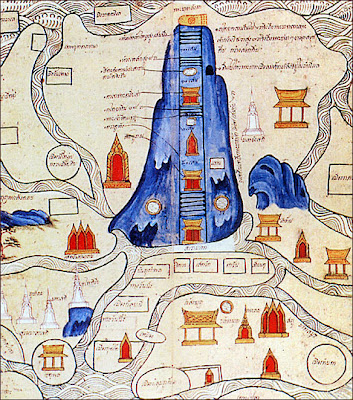How to represent the geographic space...
Since the past, human beings have had the necessity of searching or investigating how is the place where we live. The first humans that live in the world made their representations by doing some drawings where they painted natural resources like mountains, rivers, oceans, caves or other common features that surrounded them. To have a better idea of their space, these men used to go to the highest pick and look to their surroundings so they can start doing their sketches; others, used to travel by the shores and in that way they could have the maps of the territory they lived in; they were also guided by the sun or the stars.
Can you imagine having the maps from that time, do you think we could be able to understand them?
 |
Source: mappa.mundi.net
|
"What we all love about ancient maps is that they communicate more than mere spacial, geographic concepts. They are treasure troves of information and insights into past cultures, revealing notions of sovereignty, nationhood, national priorities and loyalties, the level of scientific advancement of the day, astronomical charts, religious beliefs, speculations of deep sea creatures, and the locations of important events. Modern maps are, thanks to scientific advancements, more accurate and precise, but sadly, they have lost a lot of their depth of meaning." (ballantynethenbrave.com blog)
It was until XIX and XX century when technology advances allowed the improvement of maps because it make them close to reality.
Today, we can use different things to get to know our geographic space, there are satellite images, aerial pictures, 3d maps, sketches, GPS, even a globe.
Who make those maps? For what reason we need pictures from satellites? There are a lot of reasons why we need them; imagine your family wants to establish a business, let's say a restaurant, how they are going to search about the area where to put the restaurant? Using images from satellites we can search about location, if it's good or convenient. How do you think they can search people? YES! with maps! According to the interest is what you will use.
Types of Representation...
*Sketch: The easiest way to represent geographic space, it's a simple drawing that works to locate a place and its route.
*Map: It is the most conventional way to represent a humanized space, it needs to have very specific directions.
*Globe: A sphere that has the most accurate representation, why? because is the same shape as our planet!
*Satellite images: Is an image taken from space by a satellite, using this image we can know about process and natural phenomena that affect geographic psace. Nowadays we have Google Earth as well as Google Maps.
*3d Images: They represent a part of the land, specifically landforms like mountains, hills, etc. With this tool we can get a more real idea about our geographic space.
*Aerial photo: these photos are taken with special cameras that are placed in airplanes flying at certain height; these pictures are used to create maps.

















